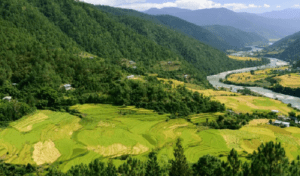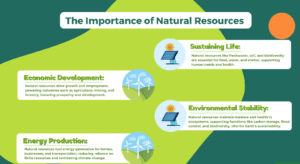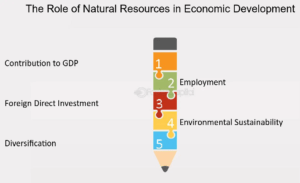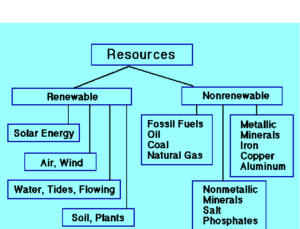
A. Introduction:
1. What are natural resources?
Natural resources are the foundation of life on Earth. They encompass everything from the air we breathe and the water we drink to the minerals that power our technologies and the forests that provide habitats for countless species. These resources not only sustain our daily lives but also play a crucial role in shaping our economies, cultures, and environments.

As our global population continues to grow and our consumption patterns evolve, understanding the significance of these resources becomes increasingly vital.
Natural resources are materials from the environment that people use. Earth’s natural resources are materials that are used to support life and meet human requirements.
The phrase “natural resource depletion” refers to how few resources are still present on Earth. As we use resources more quickly than they can be replenished, that occurs. Right now, that is a really serious problem. The rapid depletion of natural resources is one of the toughest environmental issues facing the globe.
According to Wikipedia,
“Natural resources are resources that exist without actions of humankind. This includes all valued characteristics such as magnetic, gravitational, and electrical properties and forces.
On earth, it includes sunlight, atmosphere, water, land along with all vegetation and animal life that naturally subsists upon or within the heretofore identified characteristics and substances.“
2. Purpose of the Post
The primary intent of this post is to illuminate the importance of 21 selected natural resources that are essential for human survival and ecological balance.
By exploring their significance and diverse uses, we aim to foster a deeper appreciation for these resources. Additionally, we will emphasize the urgent need for conservation and responsible management practices.
In a world where resource depletion and environmental degradation are pressing concerns, it is imperative that we adopt sustainable practices that ensure the availability of these resources for future generations.
B. Why are natural resources critical?

Essential for Life:
Many of the natural resources—water, air, and soil—are basic for life itself. Drinking, farming, and sanitation depend on water. For breathing, air offers oxygen; it is also absolutely essential for many industrial operations. Thus, on the basis of agriculture, soil supports plant development and offers necessary nutrients.
Economic Importance:

The foundation of economies all around is natural resources. Development of infrastructure, manufacturing, and industry depends on minerals, fossil fuels, and metals. They produce jobs, boost national wealth, and propel economic development.
Energy Sources:
Meeting energy needs depends critically on fossil fuels, including coal, oil, and natural gas, as well as renewable sources, including sunlight, wind, and geothermal energy. Homes, companies, transportation, and technological developments all run on energy resources.
Biodiversity and Ecosystem Services:
Forests, sea resources, and regions rich in biodiversity all offer ecosystem services like carbon sequestration, climate control, water purification, and habitat for species. Maintaining biodiversity and ecological balance depends on the preservation of natural environments.
Food Security:
The production of food depends critically on agricultural resources like land, water, and biodiversity. Sustainable farming methods guarantee food security, nutrition, and resistance against various issues, such as climate change.
Cultural and social significance:
For societies all around, natural resources are both socially and culturally significant. Often related to traditional activities, livelihoods, and cultural legacy, they shape identities and ways of life.
Climate and Environmental Stability:
Natural resources help to control climate, cycle carbon, and preserve environmental stability. Reducing climate change and saving the earth for next generations depend on protecting ecosystems, lowering pollution, and changing to sustainable resource usage.
Natural resources are crucial overall because they are fundamental for sustaining life, supporting economies, generating energy, preserving biodiversity, guaranteeing food security, protecting culture, and so defending the environment. A sustainable and rich future depends on effective management, protection of these resources, and sustainable use of them.
C. Overview of the 21 Selected Natural Resources

Here is a classified list of natural resources.
1. Renewable Resources
Renewable resources are natural resources that can be replenished or regenerated within a reasonable timeframe, either through natural processes or with the help of human management and technology. These resources are considered sustainable, as they can be utilized without being depleted or permanently damaged.
Examples of renewable resources include:
- Solar energy: The sun’s radiant energy can be harnessed to generate electricity through photovoltaic systems and solar thermal technologies.
- Wind energy: The kinetic energy of wind can be converted into electricity using wind turbines.
- Hydropower: The energy of flowing or falling water can be used to generate electricity through hydroelectric power plants.
- Biomass: Organic matter, such as wood, agricultural waste, and energy crops, can be used as a renewable source of energy.
- Geothermal energy: The heat stored within the Earth’s crust and mantle can be tapped to generate electricity or provide heating and cooling.
Renewable resources are generally considered more environmentally friendly and sustainable compared to non-renewable resources, as they can be replenished or replaced over time. However, their utilization still requires careful management and conservation to ensure long-term availability.
2. Non-Renewable Resources
Non-renewable resources are natural resources that are finite and cannot be replenished or regenerated within a reasonable timeframe. These resources are typically extracted from the Earth’s crust and are consumed at a faster rate than they can be naturally replaced.
Examples of non-renewable resources include:
- Fossil fuels: Oil, coal, and natural gas are the primary fossil fuels used for energy production and transportation.
- Minerals: Metals, such as gold, copper, iron, and rare earth elements, are essential for various industrial and technological applications.
- Nuclear energy: Uranium and other radioactive materials are used as fuel for nuclear power generation.
Non-renewable resources are often considered more valuable and economically significant, as they are essential for powering modern societies and supporting industrial development.
However, their finite nature and the environmental impacts associated with their extraction and use have led to increasing efforts to transition towards more sustainable, renewable alternatives.
The responsible and sustainable management of both renewable and non-renewable resources is crucial for ensuring the long-term availability and balanced utilization of natural resources, while minimizing environmental degradation and addressing the challenges of climate change and resource depletion.
D. Some statistics related to natural resources:
Water Resources:
Though just over 2.5% of the area of the Earth is freshwater, almost 71% of its surface is covered with water. Safely regulated drinking water services are not available to over two billion people globally.
More than 40% of the world’s population lives in locations where water is scarce for at least one month annually; forecasts show that by 2025, about 5.7 billion people could be residing in such conditions.
Energy Resources:
Right now, around 80% of the world’s energy needs come from fossil fuels—coal, oil, and natural gas. About 20% of world electricity generation comes from renewable energy sources (solar, wind, hydroelectric, and geothermal); solar and wind energy have experienced explosive increases recently.
The International Energy Agency (IEA) projects a 25% rise in global energy use by 2040, therefore underscoring the continuous dependence on energy supplies.
Mineral Resources:
With the World Bank projecting that minerals and metal extraction contributed roughly 3.7% of the global GDP in 2019, the mining sector makes a major contribution to the GDP worldwide.
Because they are so important for technologies like electric vehicles, renewable energy systems, and electronics, demand for crucial minerals, including rare earth elements, lithium, and cobalt, is growing.
Forests and biodiversity:
Although forests account for around 31% of the total area on Earth, rates of deforestation remain high—an estimated 10 million hectares of forest are lost annually.
With the World Wildlife Fund (WWF) noting that wildlife populations have dropped by 68% on average since 1970, the loss of biodiversity resulting from habitat degradation, pollution, climate change, and other causes is a major worry.
Food and Agriculture:
With almost 70% of world freshwater consumed in agriculture, food production’s water-intensive character is clear. The Food and Agriculture Organization (FAO) estimates that 690 million people globally go hungry; food insecurity is compounded by elements including climate change, conflict, and financial difficulties.
These figures highlight the need for responsible use of natural resources, conservation, and sustainable management in order to solve global issues including food security, energy transition, water scarcity, and biodiversity loss.
keeps up its current pace. The same issue applies to oil: fossil fuels still play a significant role in our energy system.
E. Overview of the 21 Selected Natural Resources
1. Water
Significance: Water is an essential natural resource for life, agriculture, and industry. It is crucial for human survival, supporting various ecosystems, and enabling economic activities.
Uses:
- Drinking and domestic use
- Irrigation for agriculture
- Industrial processes and manufacturing
- Sanitation and hygiene
Conservation Tips:
- Rainwater harvesting to supplement water supplies
- Reducing water waste through efficient usage and recycling
- Implementing water-saving technologies in agriculture and industry
- Protecting and restoring water bodies, such as lakes, rivers, and wetlands
- Promoting public awareness and education on water conservation
2. Soil
Significance: Soil is a vital natural resource that supports plant growth, agricultural productivity, and ecosystem health. It is the foundation for terrestrial life.
Uses:
- Cultivation of crops and food production
- Growth of forests and other vegetation
- Habitat for a diverse range of organisms
- Construction and infrastructure development
Conservation Tips:
- Implementing sustainable farming practices, such as crop rotation and no-till agriculture
- Preventing soil erosion through cover cropping, terracing, and vegetation management
- Maintaining soil fertility through organic matter addition and responsible use of fertilizers
- Protecting and restoring degraded or contaminated soils
3. Fossil Fuels (Oil, Coal, and Natural Gas)
Significance: Fossil fuels are non-renewable energy resources that have been the primary source of power for modern civilization, driving industrialization and economic development.
Uses:
- Electricity generation
- Transportation (gasoline, diesel, jet fuel)
- Industrial processes and manufacturing
- Heating and cooking
Conservation Tips:
- Transitioning to renewable energy sources, such as solar, wind, and hydropower
- Improving energy efficiency in various sectors to reduce fossil fuel consumption
- Investing in research and development of alternative energy technologies
- Promoting policies and regulations to incentivize the use of clean energy
4. Renewable Energy (Solar, Wind, Hydropower, Geothermal, Biomass)
Significance: Renewable energy sources are sustainable and environmentally friendly alternatives to fossil fuels, playing a crucial role in mitigating climate change and reducing greenhouse gas emissions.
Uses:
- Electricity generation
- Heating and cooling
- Transportation (biofuels)
- Industrial and commercial applications
Conservation Tips:
- Expanding the deployment of renewable energy technologies
- Investing in research and development to improve efficiency and cost-effectiveness
- Implementing policies and incentives to encourage the adoption of renewable energy
- Promoting public awareness and education on the benefits of renewable energy
5. Minerals and Metals
Significance: Minerals and metals are essential natural resources that are vital for various industries, technological advancements, and infrastructure development.
Uses:
- Construction materials (e.g., steel, aluminum, copper)
- Electronics and high-tech products
- Industrial processes and manufacturing
- Jewelry and decorative items
Conservation Tips:
- Promoting recycling and the circular economy to reduce the demand for new mineral extraction
- Improving mining practices to minimize environmental impact and ensure worker safety
- Investing in the exploration and development of new mineral deposits
- Encouraging the use of alternative materials and substitutes where possible
6. Forests and Timber
Significance: Forests are complex ecosystems that provide numerous ecological, economic, and social benefits, including carbon sequestration, biodiversity conservation, and timber production.
Uses:
- Timber for construction, furniture, and paper production
- Fuel wood and charcoal
- Non-timber forest products (e.g., fruits, herbs, resins)
- Recreational and ecotourism activities
Conservation Tips:
- Practicing sustainable forest management, including selective logging and reforestation
- Protecting and expanding protected areas and national parks
- Promoting agroforestry and community-based forest management
- Combating illegal logging and deforestation through stricter regulations and enforcement
7. Fisheries and Marine Resources
Significance: Oceans, seas, and freshwater bodies provide a wealth of natural resources, including fish, shellfish, and other marine life, which are essential for food security, livelihoods, and ecosystem balance.
Uses:
- Seafood and aquaculture production
- Extraction of minerals and energy resources (e.g., offshore oil and gas)
- Coastal tourism and recreation
- Regulation of the global climate and weather patterns
Conservation Tips:
- Implementing sustainable fishing practices and quotas to prevent overfishing
- Protecting and restoring marine habitats, such as coral reefs and mangroves
- Reducing pollution and plastic waste in oceans and waterways
- Promoting aquaculture and mariculture as alternatives to wild-caught seafood
8. Wildlife and Biodiversity
Significance: Biodiversity, which includes the variety of plant and animal species, is essential for the functioning of ecosystems, providing food, medicine, and other valuable resources.
Uses:
- Ecotourism and wildlife-based economies
- Genetic resources for agriculture and medicine
- Maintenance of ecological balance and ecosystem services
- Cultural and spiritual significance for many communities
Conservation Tips:
- Establishing and expanding protected areas and national parks
- Combating illegal wildlife trade and poaching
- Promoting sustainable land-use practices and habitat restoration
- Investing in research and conservation efforts to protect endangered species
9. Freshwater Resources
Significance: Freshwater resources, such as rivers, lakes, and groundwater, are critical for human consumption, agriculture, industry, and the maintenance of aquatic ecosystems.
Uses:
- Drinking water supply
- Irrigation for agriculture
- Industrial and manufacturing processes
- Hydroelectric power generation
Conservation Tips:
- Improving water use efficiency and reducing waste in various sectors
- Protecting and restoring watersheds, wetlands, and aquifer recharge areas
- Implementing wastewater treatment and water recycling technologies
- Addressing pollution and contamination of freshwater sources
10. Grasslands and Rangelands
Significance: Grasslands and rangelands provide forage for livestock, support biodiversity, and play a role in regulating the global climate through carbon sequestration.
Uses:
- Grazing and livestock production
- Wildlife habitat and biodiversity conservation
- Recreational activities, such as hiking and ecotourism
- Regulation of the global climate through carbon storage
Conservation Tips:
- Implementing sustainable grazing practices and rotational grazing systems
- Protecting and restoring degraded grasslands and rangelands
- Promoting the integration of livestock and wildlife management
- Investing in research and development of sustainable rangeland management techniques
11. Peatlands and Wetlands
Significance: Peatlands and wetlands are unique ecosystems that provide important ecological services, such as flood control, water purification, and carbon sequestration.
Uses:
- Habitat for diverse plant and animal species
- Regulation of water flows and flood control
- Filtration and purification of water resources
- Carbon storage and climate regulation
Conservation Tips:
- Protecting and restoring peatlands and wetlands from drainage and conversion
- Implementing sustainable management practices to maintain their ecological functions
- Promoting public awareness and education on the importance of these ecosystems
- Integrating peatland and wetland conservation into land-use planning and policies
12. Geologic Resources (Rocks, Minerals, Fossils)
Significance: Geologic resources, such as rocks, minerals, and fossils, provide valuable information about the Earth’s history, formation, and evolution, and are also used in various industrial and scientific applications.
Uses:
- Construction materials (e.g., stone, gravel, sand)
- Mineral resources for industrial and technological applications
- Paleontological and geological research and education
- Decorative and ornamental purposes
Conservation Tips:
- Promoting sustainable extraction and responsible mining practices
- Protecting and preserving important geological sites and fossil deposits
- Encouraging the reuse and recycling of geologic resources where possible
- Investing in research and exploration to discover new deposits
13. Atmospheric Resources (Air, Ozone Layer, Climate)
Significance: The Earth’s atmosphere, including the air, ozone layer, and climate, is a critical natural resource that supports life, regulates the global climate, and protects the planet from harmful radiation.
Uses:
- Provision of oxygen for respiration
- Regulation of temperature and weather patterns
- Absorption and filtration of solar radiation
- Enabling aviation and other atmospheric activities
Conservation Tips:
- Reducing greenhouse gas emissions to mitigate climate change
- Protecting the ozone layer by phasing out ozone-depleting substances
- Promoting sustainable practices that minimize air pollution and maintain air quality
- Investing in research and technologies to better understand and manage atmospheric resources
14. Land and Topographical Resources (Mountains, Valleys, Deserts)
Significance: The diverse landforms and topographical features of the Earth’s surface provide a wide range of natural resources, habitats, and recreational opportunities.
Uses:
- Mineral and energy resource extraction
- Agricultural and pastoral activities
- Recreational and tourism activities
- Habitat for unique flora and fauna
Conservation Tips:
- Implementing sustainable land-use practices and zoning regulations
- Protecting sensitive or fragile landscapes, such as mountains and deserts
- Promoting ecotourism and sustainable tourism to minimize environmental impact
- Restoring degraded or damaged land through reforestation and habitat rehabilitation
15. Genetic Resources (Plant and Animal Diversity)
Significance: The genetic diversity of plants and animals is a valuable natural resource that provides the foundation for agriculture, medicine, and the maintenance of healthy ecosystems.
Uses:
- Crop improvement and development of new plant varieties
- Identification of new medicinal compounds and pharmaceutical products
- Maintenance of ecosystem functions and services
- Preservation of cultural and traditional knowledge
Conservation Tips:
- Establishing and expanding protected areas and gene banks to conserve genetic diversity
- Promoting sustainable agricultural practices that maintain genetic diversity
- Combating illegal poaching and trade of endangered species
- Investing in research and development of sustainable utilization of genetic resources
16. Bioluminescent Resources (Fireflies, Plankton, Fungi)
Significance: Bioluminescent organisms, such as fireflies, plankton, and certain fungi, produce natural light through a chemical reaction, which has various ecological, scientific, and commercial applications.
Uses:
- Ecotourism and nature-based experiences
- Biomedical research and development
- Bioindicators of environmental health
- Decorative and artistic purposes
Conservation Tips:
- Protecting habitats and ecosystems that support bioluminescent organisms
- Reducing light pollution and maintaining dark sky areas to preserve bioluminescent displays
- Promoting sustainable tourism and ecotourism practices to minimize disturbance
- Investing in research to better understand and conserve bioluminescent resources
17. Geothermal Resources
Significance: Geothermal energy, derived from the Earth’s internal heat, is a renewable and sustainable source of energy that can be harnessed for electricity generation and direct heating applications.
Uses:
- Electricity generation through geothermal power plants
- Direct use for heating and cooling of buildings
- Industrial processes and agricultural applications
- Recreational activities, such as hot springs and spas
Conservation Tips:
- Developing geothermal energy projects in an environmentally responsible manner
- Promoting the use of geothermal energy as a clean and renewable alternative to fossil fuels
- Investing in research and development to improve the efficiency and cost-effectiveness of geothermal technologies
- Ensuring the sustainable management and extraction of geothermal resources
18. Volcanic Resources (Lava, Ash, Minerals)
Significance: Volcanic resources, such as lava, ash, and minerals, have both beneficial and hazardous impacts on the environment, and can be utilized for various purposes.
Uses:
- Construction materials (e.g., volcanic rock, pumice)
- Soil enrichment and agricultural applications
- Geothermal energy production
- Scientific research and education
Conservation Tips:
- Developing early warning systems and disaster preparedness plans for volcanic eruptions
- Promoting sustainable extraction and utilization of volcanic resources
- Investing in research to better understand and mitigate the risks associated with volcanic activity
- Integrating volcanic resource management into land-use planning and policies
19. Coral Reefs and Reef Resources
Significance: Coral reefs are highly diverse and productive marine ecosystems that provide numerous ecological, economic, and social benefits, including coastal protection, fisheries, and tourism.
Uses:
- Habitat for a wide variety of marine life
- Source of food and livelihood for coastal communities
- Potential for pharmaceutical and biotechnological applications
- Recreational and ecotourism activities
Conservation Tips:
- Reducing local and global threats to coral reefs, such as pollution, overfishing, and climate change
- Promoting sustainable fishing practices and the establishment of marine protected areas
- Investing in coral reef restoration and rehabilitation projects
- Educating the public on the importance of coral reef conservation
20. Karst Landscapes and Cave Resources
Significance: Karst landscapes, characterized by sinkholes, caves, and underground drainage systems, are unique geological features that harbor valuable natural resources and support diverse ecosystems.
Uses:
- Groundwater resources and aquifer recharge
- Habitat for specialized cave-dwelling organisms
- Recreational activities, such as caving and ecotourism
- Scientific research and paleontological discoveries
Conservation Tips:
- Protecting karst landscapes and cave systems from development and human disturbance
- Implementing sustainable land-use practices to prevent groundwater contamination and sinkhole formation
- Promoting public awareness and education on the importance of karst ecosystems
- Investing in research to better understand and manage these fragile environments
21. Meteorological Resources (Weather, Precipitation, and Storms)
Significance: Meteorological resources, such as weather patterns, precipitation, and storms, play a crucial role in the Earth’s climate system, water cycle, and the availability of natural resources.
Uses:
- Provision of water resources for human consumption and agriculture
- Regulation of global and regional climate patterns
- Enabling various economic activities, such as transportation and energy production
- Early warning systems for natural disasters and extreme weather events
Conservation Tips:
- Improving climate change mitigation and adaptation strategies to address the impacts of meteorological changes
- Investing in weather monitoring and forecasting technologies to enhance disaster preparedness and response
- Promoting sustainable land-use practices that maintain the integrity of natural systems and their ability to regulate meteorological processes
- Educating the public on the importance of meteorological resources and the need for their conservation
F. The Importance of Conservation and Responsible Management
Natural resources are vital for sustaining life and supporting economic development. However, the overexploitation and mismanagement of these resources can lead to significant environmental degradation, loss of biodiversity, and social inequities.
Therefore, responsible management and conservation of natural resources are essential for maintaining ecological balance, promoting sustainability, and ensuring the well-being of current and future generations.
1. Ecological Balance
Responsible management of natural resources is crucial for maintaining ecological balance, which refers to the equilibrium between living organisms and their environment. Here are key points on how effective resource management contributes to this balance:
- Biodiversity Preservation:
- Healthy ecosystems support a wide variety of species, which are essential for ecological resilience. Responsible management practices, such as sustainable forestry and fishing, help maintain biodiversity by preventing habitat destruction and overexploitation of species. This diversity ensures that ecosystems can adapt to changes and continue to provide essential services.
- Ecosystem Services: Natural resources provide critical ecosystem services, including clean air and water, soil fertility, and climate regulation. Responsible management practices, such as reforestation and sustainable agriculture, enhance these services, ensuring that ecosystems function effectively. For example, wetlands act as natural water filters, improving water quality and providing flood protection.
- Climate Regulation:
- Natural resources, particularly forests and oceans, play a significant role in regulating the Earth’s climate. Deforestation and pollution can disrupt these natural processes, leading to increased greenhouse gas emissions and climate change. Effective management strategies, such as protecting existing forests and restoring degraded lands, are essential for mitigating climate change impacts.
2. Sustainability Practices
Individuals and communities can adopt various sustainable practices to conserve natural resources and promote environmental stewardship. Some notable practices include:
- Water Conservation: Implementing water-saving techniques, such as rainwater harvesting, drip irrigation, and xeriscaping, can significantly reduce water consumption. Educating communities about the importance of water conservation helps foster a culture of sustainability.
- Waste Reduction: Practicing the principles of reduce, reuse, and recycle can minimize waste generation and resource consumption. Communities can organize recycling programs, composting initiatives, and awareness campaigns to encourage responsible waste management.
- Sustainable Agriculture: Adopting sustainable farming practices, such as crop rotation, organic farming, and agroforestry, can enhance soil health, reduce chemical inputs, and increase biodiversity. These practices not only improve food security but also protect ecosystems.
- Renewable Energy Adoption: Transitioning from fossil fuels to renewable energy sources, such as solar, wind, and geothermal, reduces greenhouse gas emissions and reliance on finite resources. Communities can invest in renewable energy projects and promote energy efficiency measures.
- Community Engagement: Encouraging community involvement in conservation efforts, such as tree planting, habitat restoration, and wildlife protection, fosters a sense of ownership and responsibility towards local natural resources.
3. Role of Policy and Education
Effective policies and education play a critical role in the conservation and responsible management of natural resources. Here’s how:
- Policy Frameworks: Governments and organizations must establish and enforce policies that promote sustainable resource management. This includes regulations on resource extraction, pollution control, and land-use planning. Strong governance structures and legal frameworks are essential for ensuring compliance and accountability.
- Incentives for Conservation: Economic incentives, such as tax breaks for sustainable practices, grants for conservation projects, and market-based mechanisms like carbon pricing, can encourage individuals and businesses to adopt environmentally friendly practices.
- Education and Awareness: Promoting environmental education at all levels—schools, communities, and workplaces—raises awareness about the importance of conservation and responsible resource management. Educational programs can empower individuals to make informed choices and advocate for sustainable practices.
- Collaboration and Partnerships: Building partnerships between governments, non-governmental organizations, businesses, and local communities can enhance resource management efforts. Collaborative initiatives can facilitate knowledge sharing, capacity building, and the development of innovative solutions to conservation challenges.
G. Conclusion
The conservation and responsible management of natural resources are essential for maintaining ecological balance, promoting sustainability, and ensuring the well-being of future generations.
By adopting sustainable practices, supporting effective policies, and fostering education and awareness, we can collectively work towards a more sustainable and resilient future.
H. FAQs





Very nice information. Many more interesting blogs awaited. In india , situation may be pathetic due to no control on poppulation and pollution. Strategic focus and serious implementation of remedies on war footing to be done to save nature nationally as well as globaly.
[…] of the key issues. The growth of tourism around the world puts strain on ecosystems, habitats, and natural resources, which deteriorates our cultural and natural heritage. It is crucial to provide top priority to […]
[…] depletion of natural resources is indeed a critical global crisis that the Earth is currently facing. Human greed and […]
[…] depletion of natural resources is indeed a critical global crisis that the Earth is currently facing. Human greed and […]
[…] reforms, and public awareness campaigns. By prioritizing the protection and preservation of our natural resources, we can work towards a healthier, cleaner, and more sustainable planet for all. It is our […]
[…] global warming requires long-term sustainable practices that prioritize the conservation of natural resources, the reduction of greenhouse gas emissions, and the promotion of resilience and adaptation. This […]
[…] growth of tourism around the world puts strain on ecosystems, habitats, and natural resources, which deteriorates our cultural and natural […]
[…] involve conserving natural resources, supporting local communities, and promoting cultural […]
[…] source to the green fuel of the future is one of possibility, sustainability, and innovation. This narrative captures the effort of all of us to balance the needs of a contemporary world with […]
[…] growth of the population is a major element affecting carbon emissions. The need for resources, including energy, food, and transportation, rises along with the world’s population. Because […]
Rattling superb information can be found on web blog.Blog monetyze
This is quality work regarding the topic! I guess I’ll have to bookmark this page. See my website YH9 for content about Entrepreneurs and I hope it gets your seal of approval, too!
I am genuinely thankful to the owner of this website for sharing his brilliant ideas. I can see how much you’ve helped everybody who comes across your page. By the way, here is my webpage FQ6 about Thai-Massage.
Thank you for your sharing. I am worried that I lack creative ideas. It is your article that makes me full of hope. Thank you. But, I have a question, can you help me?